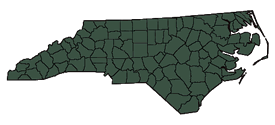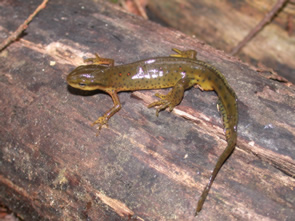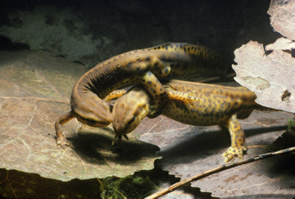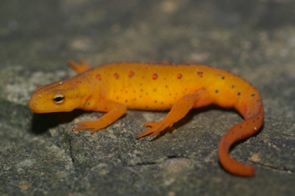 PH.jpg)
Notophthalmus viridescens
Photo by Pierson Hill
Description: Larvae are green with a dark stripe that runs from their snout to their external gills. Juveniles, also called red efts, are bright orange in coloration. They have rows of black-bordered red spots that run ventrally along either side of their body. Adults also have the spots, but they have brown or green skin and a dark stripe that runs under the eye. During mating season males develop black calluses on the inside of their hind feet. These newts range from 4 to 8 inches in length.
Habitat/Range: Red-spotted newts can be found throughout the eastern and central parts of the United States and Canada, and they range over the entirety of North Carolina. They inhabit still or slow-moving freshwater bodies. In their terrestrial stage, they are mostly found in hardwood forests and nearby areas.
Diet: Newts feed primarily on small invertebrates.
Reproduction: Males and females have an elaborate courtship ritual, which involves males wafting pheromones towards the female with their tails. After the eggs are fertilized, the female will individually lay 50 to 300 eggs on submerged vegetation. Once they hatch, the larvae will stay in the water for 2 to 5 months at which time they will metamorphose into efts. They can spend up to 7 years on land before turning into breeding adults.

The shaded region represents the range of the red-spotted newt in North Carolina.



Photo by JD Willson
Photo by JD Willson
Photo by Kristen Cecala


Newts mating.
Photo by D Dennis
Efts may be red to orange in coloration.
Photo by Jeff Hall
